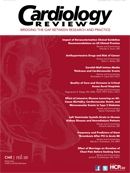Welcome Back!

Debabrata Mukherjee, MD, MS
Editor-in-Chief
W
elcome! I hope everyone had a wonderful summer. I am delighted to announce that Cardiology Review is back after a hiatus of two years, ready for a great future. We have a wonderful new team, with Jackie Syrop as our managing editor and a very distinguished Editorial Advisory Board. We hope to build on our past success and continue to provide the cardiology community insight on the latest in cardiology research and scientific findings and how they apply to current clinical practice.
This issue of the journal discusses several key clinical studies that will impact the practice of medicine and cardiology. Dr Alison Bailey summarizes a network meta-analysis of 324,168 participants from randomized trials that evaluated antihypertensive drugs and the risk of cancer. She concludes that the findings suggest no increased risk of cancer with any single antihypertensive class, but cautions against the use of ACE inhibitors in combination with ARBs for hypertension. It should be noted that the Canadian Hypertension Education Program (CHEP) expressly warns against the ACEinhibitor/ ARB combination, because the combination of the two is associated with more adverse events and no increased benefit. There is little clinical rationale to use the two together.1
Dr Mehdi Shishehbor discusses a subanalysis of the HORIZONS-AMI trial, which evaluated frequency and predictors of stent thrombosis after percutaneous coronary intervention in acute myocardial infarction. He suggests that newer P2Y12 inhibitors may be more effective in reducing stent thrombosis, consistent with the European guidelines released in September 2011 that recommend ticagrelor for all patients at moderate-to-high risk of ischemic events and prasugrel for P2Y12-inhibitor-naïve patients (especially diabetics), unless there is a high risk of life-threatening bleeding or other contraindications.
Dr Hitinder Gurm discusses the impact of national clinical guideline recommendations for revascularization of persistently occluded infarct-related arteries on clinical practice in the United States, and points out the slow impact clinical trials have on changing practice, especially when long-established practice patterns, clinical beliefs, and economic incentives are entrenched. As a society, we need to develop better ways to incorporate evidence-based guidelines more rapidly in our practices to reduce wasteful spending on procedures that are shown to be inappropriate or ineffective, and use those resources more appropriately.
Dr Ragavendra Baliga discusses the quality of care and patient outcomes in critical access rural hospitals, and highlights the opportunity to improve the standard of care by adhering to consensus guidelines for management of acute coronary syndromes, congestive heart failure, and pneumonia by improving the process systems in each hospital, training health care providers staffing these centers, implementing electronic health records, partnering with neighboring centers, and utilizing telemedicine.
Dr James Eichelberger comments on an interesting study on marriage’s effect on duration of chest pain associated with myocardial infarction, which reported a statistically significant earlier presentation during chest discomfort among married people. He contends that lack of symptom characterization and lack of ability to adequately control for potential confounders inherent in a retrospective study design likely contributes to inconsistencies in the results and limits the applicability of the findings.
Dr Mushabbar Syed discusses the association of carotidwall intima-media thickness and cardiovascular events, while Dr Srikanth Seethala comments on left ventricular systolic strain in chronic kidney disease and hemodialysis patients. Both studies highlight the prognostic ability of imaging studies to predict cardiovascular events. Dr Saurav Chatterjee discusses the effect of intensive glucose-lowering treatment on all-cause mortality, cardiovascular death, and microvascular events in type 2 diabetes, and concludes that glucose reduction may follow a curve similar to the J-shaped curve of events associated with blood pressure control, irrespective of the modality used to achieve target levels.
In our brand new Resident’s Corner, Dr Jimena Blandon opines on new resident work-hour restrictions with a personal perspective that is fun and insightful.
I hope that you will find these study synopses to be of practical value, and I would like you to share your insights, thoughts, and experiences on topics touched upon in this issue. On a broader level, I would love to hear from you to provide feedback on how we can make this journal better and more useful to your practice. My goal is to make you look forward to every issue of Cardiology Review.

Reference
1. Khan NA, Hammelgarn B, Herman RJ, et al. The 2009 Canadian hypertension education program recommendations for the management of hypertension: part 2—therapy. Can J Cardiol. 2009; 25(5):287-298.
